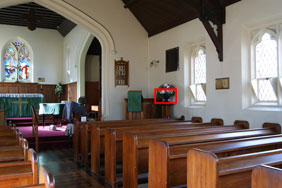Sony Alpha DSLR-A380
-
-
Written by Gordon Laing
Sony Alpha DSLR-A380 vs Nikon D90 High ISO Noise
|
 | To compare noise levels under real-life conditions we shot this scene with the Sony Alpha DSLR-A380 and Nikon D90 within a few moments of each other using each of their ISO settings. Each camera was fitted with its respective kit lens (see details below) and adjusted to deliver the same vertical field of view. The images were taken in Aperture Priority at f8 with Auto White Balance |
High ISO Noise Reduction was set to the default On and Normal settings for the A380 and D90 respectively. The Sony’s D-Range Optimizer and Nikon’s Active D-Lighting were both disabled for this test as they can artificially increase noise levels. The crops are taken from the area marked with the red rectangle near the centre of the frame, and presented here at 100%.
Note we intended to compare the A380 against the similarly-priced Nikon D5000 in these results pages, but Nikon was unable to supply one. As a replacement we used the Nikon D90, which may be a more expensive model, but one which shares the same sensor and imaging pipeline as the D5000. So while the kit lenses supplied with each of these Nikon bodies is different, much of the image quality and character you see from the D90 across these results pages is also representative of the D5000. This particularly applies to the crops taken from near the middle of the image, where both Nikkor kit lenses perform similarly, especially when closed to f8 as here. As such we believe it to be a fair comparison in terms of real-life resolution and noise levels.
Note both the A380 and D90 metered the same exposures at f8 (starting at one second for the 100 ISO sensitivity), but the D90’s resulting image was about two thirds of a stop brighter. As such, we shot the D90’s sequence here with -2/3 EV compensation to deliver a similar brightness level. This does however indicate the D90 is approximately 2/3 of a stop more sensitive than the A380 at the same ‘stated’ sensitivity. Note the D5000 shares the same sensor and image processing as the D90, so the results below are indicative of what you can expect from that model.
The Alpha A380 shares the same sensor as the earlier A350, and while Sony claims some differences in image processing, the results below are very similar. At the base level of 100 ISO, the A380 delivers a clean result, but like the A350 before it, the image is a little soft and lacking the punchiness we’d normally associate with Sony’s consumer models. In contrast, the D90 operating at one stop below its base sensitivity, is much crisper, and more detailed too despite having two fewer Megapixels.
At 200 ISO the D90 remains almost 100% clean, but the Sony sample is already showing very subtle signs of noise artefacts, while again remaining softer overall.
With the sensitivity increased to 400 ISO, the patchy artefacts of the Sony have become more apparent, and while pixel-peepers will notice slight textures on the D90 crop, it’s much preferred overall.
This patchy noise texture increases once again on the Sony A380 at 800 ISO with fine details now becoming quite smeared. In stark contrast the D90 is holding it together admirably, with only a fine noise grain in the background.
The situation deteriorates further for the A380 at 1600 ISO with an increase in undesirable chroma artefacts. Again the D90 sample is much preferred. At the A380’s maximum 3200 ISO sensitivity, the camera is really suffering, while Nikon’s D90 is still holding it together quite respectably.
Like its predecessor, the A380 allows you to switch off High ISO Noise Reduction, which is applied by default at sensitivities of 1600 and 3200 ISO. In our tests, the versions without Noise Reduction looked a little less processed, but by this sensitivity, there’s already significant losses.
This is pretty much a repeat performance of the earlier Alpha A350, which like the new model, suffered from noticeably worse noise artefacts than its main rivals, along with a lack of crispness even at the lowest sensitivity.
When we tested the A350, we assumed it was due to what was at the time the highest density APS-C sensor to date, but since then we’ve seen superior results from Pentax’s 14.6 Megapixel K20D and Canon’s 15.1 Megapixel EOS 50D / EOS 500D / Rebel T1i. The undisputed leader for high ISO performance from the APS-C format though remains the 12.3 Megapixel CMOS sensor employed by Nikon across most of its current DX DSLR range. You’ll find it in the D90, D5000 and D300s to name but three, and in each case it outperforms the competition at higher sensitivities.
So not a great result for the A380 here, but then a camera is judged by more than just its high ISO performance, and similar results for the A350 before it certainly didn’t harm sales. Now let’s take a look at more real-life samples in our Sony Alpha DSLR A380 Gallery.
Sony Alpha DSLR-A380 with Sony DT 18-55mm SAM |
Nikon D90 with Nikkor DX 18-105mm VR | |
 |  | |
100 ISO |
L1.0 (100 ISO) | |
 |  | |
200 ISO |
200 ISO | |
 |  | |
400 ISO |
400 ISO | |
 |  | |
800 ISO |
800 ISO | |
 |  | |
1600 ISO |
1600 ISO | |
 |  | |
HI 1 (3200 ISO) |
3200 ISO | |
 |  | |
6400 ISO not available |
H1.0 (6400 ISO) |




